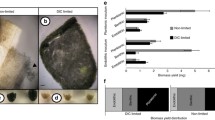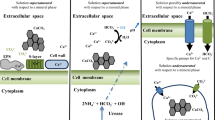Abstract
Bacteria, including cyanobacteria, as well as some fungi, are known to deposit calcium carbonate (CaCO3) extracellularly in calcium-containing artificial medium. Despite extensive investigation, the mechanisms involved in extracellular formation of CaCO3 by bacteria have remained unclear. The ability of synthetic amines to remove carbon dioxide (CO2) from natural gas led us to examine the role of biogenic polyamines in CaCO3 deposition by bacteria. Here, we demonstrated that biogenic polyamines such as putrescine, spermidine, and spermine were able to react with atmospheric CO2 and the resultant carbamate anion was characterized by using nuclear magnetic resonance (NMR) analysis. Biogenic polyamines accelerated the formation of CaCO3, and we artificially synthesized the dumbbell-shaped calcites, which had the same form as observed with bacterial CaCO3 precipitates, under nonbacterial conditions by using polyamines. The reaction rate of calcification increased with temperature with an optimum of around 40 °C. Our observation suggests a novel scheme for CO2 dissipation that could be a potential tool in reducing atmospheric CO2 levels and, therefore, global warming.








Similar content being viewed by others
References
Abd-el-Malek Y, Rizk SG (1963) Bacterial sulphate reduction and the development of alkalinity. II. Laboratory experiments with soils. J Appl Bacteriol 26:14–19
Adler HH, Kerr PF (1962) Infrared study of aragonite and calcite. Am Mineral 47:700–717
Allemand D, Tambutte E, Zoccola D, Tambutte S (2011) Coral calcification, cells to reefs. In: Dubinsky Z, Stambler N (ed) Coral reefs: An ecosystem in transition. Springer, Berlin, pp 119–150
Altschul SF, Madden TL, Schäffer AA, Zhang J, Zhang Z, Miller W, Lipman DJ (1997) Gapped BLAST and PSI-BLAST: A new generation of protein database search programs. Nucleic Acids Res 25:3389–3402
Bavendamm W (1932) Die mikrobiologische Kalkfällung in der tropischen See. Arch Microbiol 3:205–276
Boquet E, Boronat A, Ramos-Cormenzana A (1973) Production of calcite (calcium carbonate) crystals by soil bacteria is a general phenomenon. Nature 246:527–529
Crenshaw MA (1972) The inorganic composition of molluscan extrapallial fuild. Biol Bull 143:506–512
Drew GH (1913) On the precipitation of calcium carbonate in the sea by marine bacteria, and on the action of denitrifying bacteria in tropical and temperate seas. J Mar Biol Assoc 14:239–245
Ercole C, Boselli P, Altieri F, Cacchio P, Del Gallo M (2012) Calcium carbonate mineralization: Involvement of extracellular polymeric materials isolated from calcifying bacteria. Microsc Microanal 4:829–839
Erez J (2003) The source of ions for biomineralization in foraminifera and their implications for paleoceanographic proxies. Rev Mineral Geochem 54:115–149
Goeppert A, Czaun M, May RB, Prakash SGK, Olah GA (2011) Carbon dioxide capture from the air using a polyamine based regenerable solid adsorbent. J Am Chem Soc 133:20164–20167
Heldal M, Norland S, Erichsen ES, Thingstad TF, Bratbak G (2012) An unaccounted fraction of marine biogenic CaCO3 particles. PLoS ONE 7(10):e47887. doi:10.1371/journal.pone.0047887
Henry LH, Dianne KN (2009) Giomicrobiology, 5th edn. CRC Press, United States, pp 157–189
Hiraishi A (1992) Direct automated sequencing of 16S rDNA amplified by polymerase chain reaction from bacterial cultures without DNA purification. Lett Appl Microbiol 15:210–213
Jones GC, Jackson B (1993) Infrared transmission spectra of carbonate minerals. Chapman and Hall, London
Kashiwagi K, Igarashi K (2011) Identification and assays of polyamine transport systems in Escherichia coli and Saccharomyces cerevisiae. In: Pegg AE, Casero Jr RA (eds) Polyamines: Methods and protocols. Humana, New York, pp 295–308
Kitano Y (1983) Calcification and atmospheric CO2. In: Westbroek P, de Jong EW (eds) Biomineralization and biological metal accumulation. Reidel, Dordrecht, pp 89–98
Kitano Y, Hood DW (1962) Calcium carbonate crystal forms formed from seawater by inorganic processes. J Oceanogr Soc Jpn 18:141–145
Krumbein WE (1974) On the precipitation of aragonite on the surface of marine bacteria. Naturwissenschaften 61:167
Matsunaga S, Sakai R, Jimbo M, Kamiya H (2007) Long-chain polyamines (LCPAs) from marine sponge: Possible implication in spicule formation. Chembiochem 8:1729–1735
Miyamoto H, Miyashita T, Okushima M, Nakano S, Morita T, Matsushiro A (1996) A carbonic anhydrase from the nacreous layer in oyster pearls. Proc Natl Acad Sci U S A 93:9657–9660
Monty CLV (1972) Recent algal stromatolitic deposits, Andros Island, Bahamas. Preliminary report. Geol Rundsch 61:742–783
Nys Y, Zawadzki J, Gautron J, Mills AD (1991) Whitening of brownshelled eggs: Mineral composition of uterine fiuld and rate of protoporphyrin deposition. Poult Sci 70:1236–1245
Rochelle GT (2009) Amine scrubbing for CO2 capture. Science 325:1652–1654
Shinano H (1969) Studies of marine microorganisms taking part in the precipitation of calcium carbonate-1. Bull Jpn Soc Sci Fish 35:1001–1005
Sumper M, Kroger N (2004) Silica formation in diatoms: The function of long-chain biogenic polyamines and silaffins. J Mater Chem 14:2059–2065
Tabor CW, Tabor H (1985) Polyamines in microorganisms. Microbiol Rev 49:81–99
Thompson JB, Ferris FG (1990) Cyanobacterial precipitation of gypsum, calcite, and magnesite from natural alkaline lake water. Geology 18:995–998
Ume CS, Alper E (2012) Reaction kinetics of carbon dioxide with 2-amino-2-hydroxymethyl-1,3-propanediol in aqueous solution obtained from the stopped flow method. Turk J Chem 36:427–435
Ware JR, Smith SV, Reaka-Kudla ML (1992) Coral reefs: Sources or sinks of atmospheric CO2? Coral Reefs 11:127–130
Weisburg WG, Barns SM, Pelletier DA, Lane DJ (1991) 16S ribosomal DNA amplification for phylogenetic study. J Bacteriol 173:697–703
Yasumoto-Hirose M, Nishijima M, Ngirchechol MK, Kanoh K, Shizuri Y, Miki W (2006) Isolation of marine bacteria by in situ culture on media-supplemented polyurethane foam. Mar Biotechnol 8:227–237
Acknowledgments
We thank G. N. Somero for critically reading of the manuscript. We also thank the captain and crew of the R/V Natsushima (JAMSTEC) for their assistance during the NT10-13 cruise used to obtain marine bacteria, Dr. Shizuri and Ms. Katsuta for sharing the bacterial strains, and Dr. Kasai and Mrs. Inomata for their assistance of the 16S rRNA analysis of bacteria. This work was supported partly by grant-in-aids from the Japan Society for the Promotion of Science KAKENHI (grant number 23780216, 25850145, and 25740005), the Institute for Fermentation Osaka, and Kitasato University for Young Researchers.
Author information
Authors and Affiliations
Corresponding author
Electronic supplementary material
Below is the link to the electronic supplementary material.
ESM 1
(DOCX 2306 kb)
Rights and permissions
About this article
Cite this article
Yasumoto, K., Yasumoto-Hirose, M., Yasumoto, J. et al. Biogenic Polyamines Capture CO2 and Accelerate Extracellular Bacterial CaCO3 Formation. Mar Biotechnol 16, 465–474 (2014). https://doi.org/10.1007/s10126-014-9566-z
Received:
Accepted:
Published:
Issue Date:
DOI: https://doi.org/10.1007/s10126-014-9566-z




